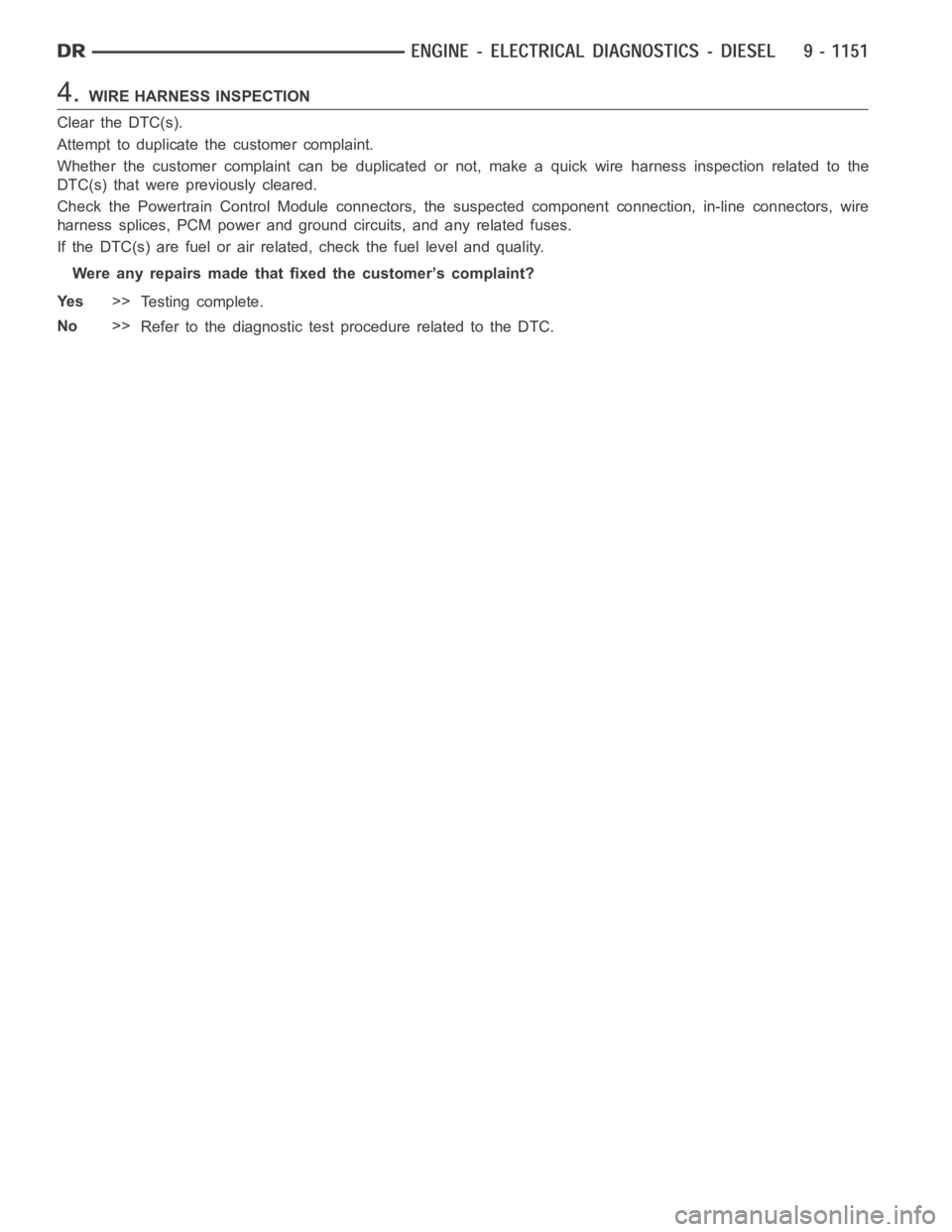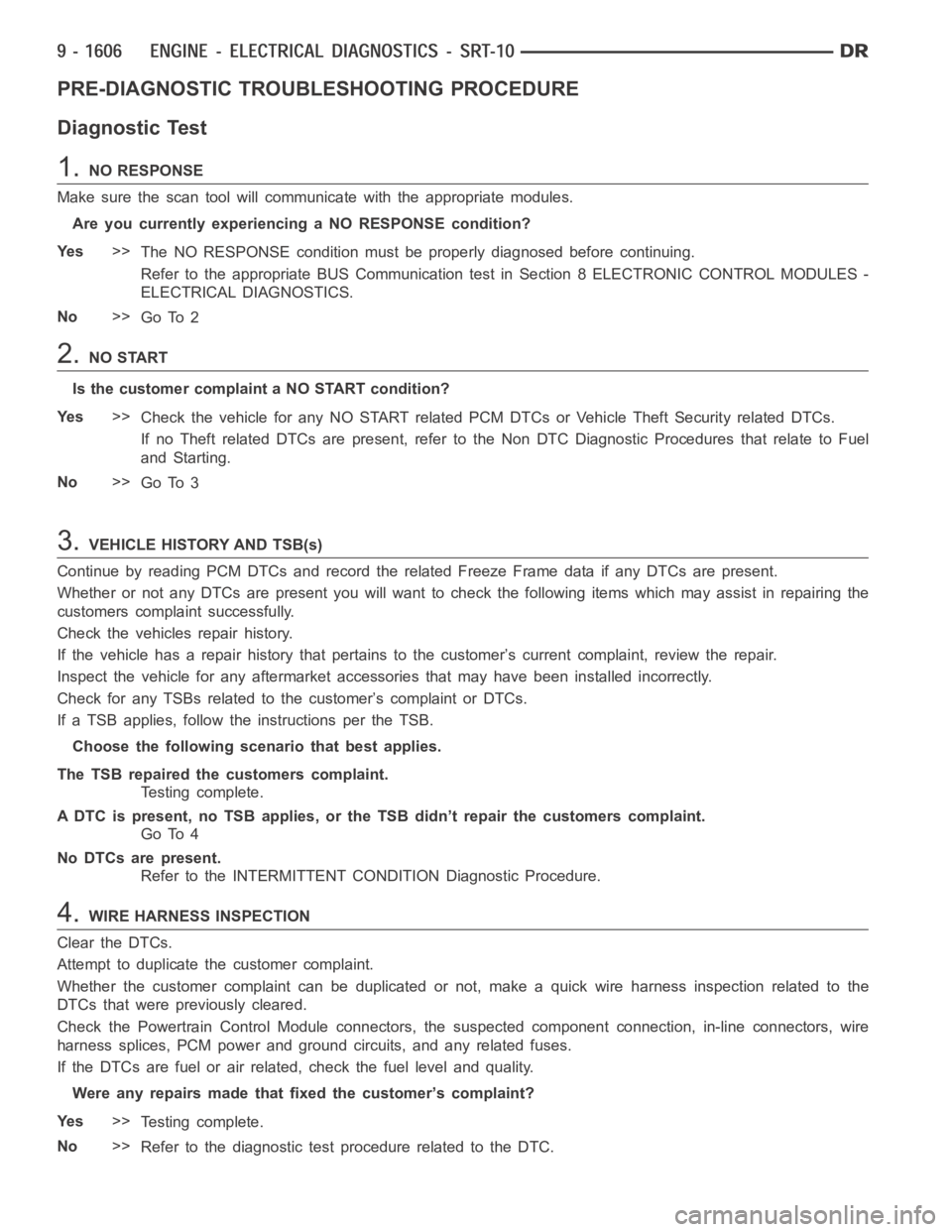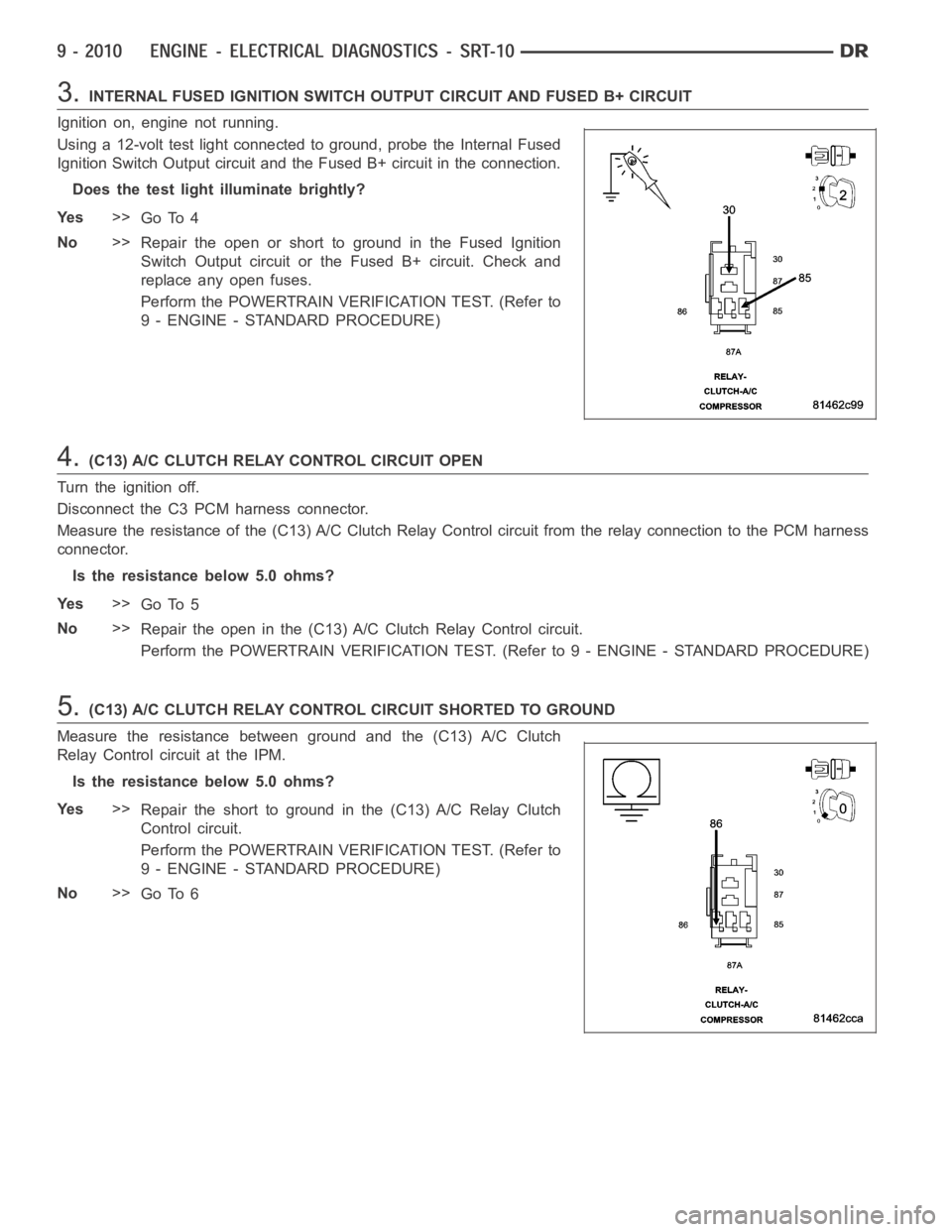2006 DODGE RAM SRT-10 fuses
[x] Cancel search: fusesPage 13 of 5267

When Monitored:
With ignition on. Battery voltage above 10 volts.
Set Condition:
The actual ASD state is not equal to the desired ASD state. One Trip Fault. Three good trips to turn off the
MIL.
Possible Causes
INTERNAL FUSED B+ CIRCUITS
(K51) ASD RELAY CONTROL CIRCUIT OPEN
(K51) ASD RELAY CONTROL CIRCUIT SHORTED TO GROUND
ASD RELAY
PCM
Always perform the Pre-Diagnostic Troubleshooting procedure before proceeding. (Refer to 9 - ENGINE -
DIAGNOSIS AND TESTING).
Diagnostic Test
1.ASD RELAY OPERATION
Ignition on, engine not running.
With a scan tool, actuate the ASD Relay.
Is the ASD Relay operating?
Ye s>>
Refer to the INTERMITTENT CONDITION Diagnostic Procedure.
Perform the POWERTRAIN VERIFICATION TEST. (Refer to 9 - ENGINE - STANDARD PROCEDURE)
No>>
Go To 2
2.INTERNAL FUSED B+ CIRCUITS
Turn the ignition off.
Remove the ASD Relay from the IPM.
Using a 12-volt test light connected to ground, probe the Internal Fused
B+ circuits in the IPM.
Does the test light illuminate brightly?
Ye s>>
Go To 3
No>>
Repair the open or short to ground in the Internal Fused B+
circuits. Inspect and replace any open fuses.
Perform the POWERTRAIN VERIFICATION TEST. (Refer to
9 - ENGINE - STANDARD PROCEDURE)
3.ASD RELAY
Measure the resistance of the ASD Relay Coil.
Is the resistance between 60 to 80 ohms?
Ye s>>
Go To 4
No>>
Replace the ASD Relay.
Perform the POWERTRAIN VERIFICATION TEST. (Refer to 9 - ENGINE - STANDARD PROCEDURE)
Page 433 of 5267

Possible Causes
NO START PRE-TEST
POWERTRAIN FUSES OPEN
SECONDARY INDICATORS PRESENT
ENGINE MECHANICAL
(K342) ASD RELAY OUTPUT CIRCUITS OPEN
FUEL CONTAMINATION
Diagnostic Test
1.NO START PRE-TEST
NOTE: The following list of items must be checked before continuing with any no start tests.
The battery must be fully charged and in good condition. A low charged battery may produce invalid test results. If
the battery is low, charge the battery and then attempt to start the vehicleby cranking the engine for 15 seconds,
3 consecutive times.
This will allow any DTCs to set that may have been erased due to a dead battery.
Try to communicate with PCM if not able to communicate check fuses.
Make sure the Powers and Ground to the PCM are OK.
Make sure the PCM communicates with the scan tool and that there are no DTCs stored in the PCM memory. If the
PCM reports a No Response condition, refer to section 8 Electrical Electronic Control Module Electrical Diagnostics
for the proper tests.
Read the PCM DTCs with the scan tool. If any DTCs are present, they must be repaired before continuing with any
other No Start diagnostic tests. Refer to the Table of Contents for the related P-code that is reported by the PCM.
Make sure that the Bus is functional. Attempt to communicate with the Instrument Cluster and VTSS, If you are
unable to establish communications refer to 8 Electrical Electronic Control Module Electrical Diagnostics for the
proper Diagnostic procedures.
The Sentry Key Immobilizer System mustbe operating properly. Check for proper communication with the scan tool
and check for DTCs that may be stored in the Sentry Key Immobilizer Module (SKIM). Repair the DTC(s) before
continuing.
If no DTCs are found, using the scan tool, select Clear PCM (BATT Disconnect).
Crank the engine several times. Using the scan tool, read DTCs. If a DTC is present perform the DTC diagnostics
before continuing.
Were any problems found?
Ye s>>
Repair as necessary.
Perform the POWERTRAIN VERIFICATION TEST. (Refer to 9 - ENGINE - STANDARD PROCEDURE)
No>>
Go To 2
2.OPEN FUSE
Check for any open fuses in the IPM or Junction Block that may be related to theNoStartcondition.
Are any of the fuses open?
Ye s>>
Replace the open fuse and check the related circuit(s) for a short to ground.
Perform the POWERTRAIN VERIFICATION TEST. (Refer to 9 - ENGINE - STANDARD PROCEDURE)
No>>
Go To 3
Page 439 of 5267

3.EXCESSIVE RESISTANCE IN THE BATTERY CIRCUIT
Turn the ignition off.
Check the Battery Cables for excessive resistance using the service information procedure.
Did either Battery Cable have a voltage drop greater than 0.2 of a volt?
Ye s>>
Repair the excessive resistance in the Battery circuit.
Perform the POWERTRAIN VERIFICATION TEST. (Refer to 9 - ENGINE - STANDARD PROCEDURE)
No>>
Go To 4
4.STARTER RELAY
Turn ignition off.
Remove the Starter Relay from IPM.
CAUTION: The Parking Brake must be on and the Transmission must be in park for a vehicle equipped with
an automatic transmission.
WARNING: When the engine is operating, do not stand in direct line with the fan. Do not put your hands
near the pulleys, belts, or fan. Do notwear loose clothing. Failure to follow these instructions can result in
personal injury or death.
Briefly connect a jumper wire from the Internal Fused B+ circuit to the (T750) Starter Relay Output circuit.
Did the Starter Motor crank the engine?
Ye s>>
Go To 5
No>>
Go To 7
5.(T751) FUSED IGNITION SWITCH OUTPUT CIRCUIT
Ignition on, engine not running.
Using a 12-volt test light, probe the (T751) Fused Ignition Switch Output circuit in the Starter Relay connector.
While observing 12-volt test light, hold ignition key in the start position.
Does the test light illuminate brightly?
Ye s>>
Go To 6
No>>
Repair the excessive resistance in the(T751)FusedIgnitionSwitchOutput circuit. Inspect related fuses
and repair as necessary.
Perform the POWERTRAIN VERIFICATION TEST. (Refer to 9 - ENGINE - STANDARD PROCEDURE)
Page 440 of 5267

6.(T752) STARTER RELAY CONTROL CIRCUIT OPEN
Turn the ignition off.
Remove the Starter Relay from the IPM.
Disconnect the C3 PCM harness connector.
Measure the resistance in the (T752) Starter Relay Control circuit from
the Relay terminal to the appropriate terminals of special tool #8815.
Is the resistance below 5.0 ohms?
Ye s>>
Replace the Starter Motor Relay.
Perform the POWERTRAIN VERIFICATION TEST. (Refer to
9 - ENGINE - STANDARD PROCEDURE)
No>>
Repair the open in the (T752) Starter Relay Control circuit.
Perform the POWERTRAIN VERIFICATION TEST. (Refer to
9 - ENGINE - STANDARD PROCEDURE)
7.INTERNAL FUSED B+ CIRCUIT OPEN
Turn the ignition off.
Using a 12-volt test light connected to ground, probe the Internal Fused B+circuit at the Starter Relay terminal.
Does the test light illuminate brightly?
Ye s>>
Go To 8
No>>
Repair the excessive resistance in the Internal Fused B+ circuit. Inspectrelated fuses and repair as
necessary.
Perform the POWERTRAIN VERIFICATION TEST. (Refer to 9 - ENGINE - STANDARD PROCEDURE)
8.(T750) STARTER RELAY OUTPUT CIRCUIT OPEN
Disconnect the Starter Relay Output connector from the Starter Sole-
noid.
Measure the resistance of the (T750) Starter Relay Output circuit
between the Relay and the Solenoid harness connector.
Is the resistance below 5.0 ohms?
Ye s>>
Go To 9
No>>
Repair the open in the Starter Relay Output circuit.
Perform the POWERTRAIN VERIFICATION TEST. (Refer to
9 - ENGINE - STANDARD PROCEDURE)
Page 443 of 5267

Possible Causes
(A919) PCM FUSED B+ CIRCUIT
PCM NO RESPONSE
(F202) (F1) (T751) PCM FUSED IGNITION SWITCH OUTPUT CIRCUITS
(Z130) (Z131) PCM GROUND CIRCUITS
CRANKSHAFT POSITION SENSOR
(F855) 5-VOLT SENSOR OPEN/SHORTED
(F855) 5-VOLT SUPPLY CIRCUIT SHORTED TO GROUND
(F856) 5-VOLT SUPPLY CIRCUIT SHORTED TO GROUND
PCM
Diagnostic Test
1.(A919) PCM FUSED B+ CIRCUIT
NOTE: The scan tool and cable must be operating properly for the
resultsofthistesttobevalid.
NOTE: Make sure the ignition switch was on while trying to com-
municate with the PCM.
Turn the ignition off.
Disconnect the PCM harness connectors.
CAUTION: Do not probe the PCM harness connectors. Probing the
PCM harness connectors will damage the PCM terminals resulting
in poor terminal to pin connection. Install Miller Special Tool #8815
to perform diagnosis.
Using a 12-volt test light connected to ground probe the appropriate ter-
minal of special tool #8815.
Does the test light illuminate brightly?
Ye s>>
Go To 2
No>>
Repair the open or short to ground in the (A919) Fused B+
circuit. Inspect and replace fuses as necessary.
Perform the POWERTRAIN VERIFICATION TEST. (Refer to 9 - ENGINE - STANDARD PROCEDURE)
2.(F202), (F1), (T751) PCM FUSED IGNITION SWITCH CIRCUITS
Using a 12-volt test light connected to ground, probe the PCM Fused
Ignition Switch Output circuits in the appropriate terminals of special tool
#8815.
Does the test light illuminate brightly?
Ye s>>
Go To 3
No>>
Repair the (F202) (F1) (T751) Ignition Switch Output cir-
cuits. Inspect and replace fuses as necessary.
Perform the POWERTRAIN VERIFICATION TEST. (Refer to
9 - ENGINE - STANDARD PROCEDURE)
Page 460 of 5267

4.WIRE HARNESS INSPECTION
Clear the DTC(s).
Attempt to duplicate the customer complaint.
Whether the customer complaint can be duplicated or not, make a quick wire harness inspection related to the
DTC(s) that were previously cleared.
Check the Powertrain Control Module connectors, the suspected componentconnection, in-line connectors, wire
harness splices, PCM power and ground circuits, and any related fuses.
If the DTC(s) are fuel or air related, check the fuel level and quality.
Were any repairs made that fixed the customer’s complaint?
Ye s>>
Testing complete.
No>>
Refer to the diagnostic test procedure related to the DTC.
Page 915 of 5267

PRE-DIAGNOSTIC TROUBLESHOOTING PROCEDURE
Diagnostic Test
1.NO RESPONSE
Make sure the scan tool will communicate with the appropriate modules.
Are you currently experiencing a NO RESPONSE condition?
Ye s>>
The NO RESPONSE condition must be properly diagnosed before continuing.
Refer to the appropriate BUS Communication test in Section 8 ELECTRONIC CONTROL MODULES -
ELECTRICAL DIAGNOSTICS.
No>>
Go To 2
2.NO START
Is the customer complaint a NO START condition?
Ye s>>
Check the vehicle for any NO START related PCM DTCs or Vehicle Theft Security related DTCs.
If no Theft related DTCs are present, refer to the Non DTC Diagnostic Procedures that relate to Fuel
and Starting.
No>>
Go To 3
3.VEHICLE HISTORY AND TSB(s)
Continue by reading PCM DTCs and record the related Freeze Frame data if anyDTCs are present.
Whether or not any DTCs are present you will want to check the following items which may assist in repairing the
customers complaint successfully.
Check the vehicles repair history.
If the vehicle has a repair history that pertains to the customer’s currentcomplaint, review the repair.
Inspect the vehicle for any aftermarket accessories that may have been installed incorrectly.
Check for any TSBs related to thecustomer’s complaint or DTCs.
If a TSB applies, follow the instructions per the TSB.
Choose the following scenario that best applies.
The TSB repaired the customers complaint.
Testing complete.
A DTC is present, no TSB applies, or the TSB didn’t repair the customers complaint.
Go To 4
No DTCs are present.
Refer to the INTERMITTENT CONDITION Diagnostic Procedure.
4.WIRE HARNESS INSPECTION
Clear the DTCs.
Attempt to duplicate the customer complaint.
Whether the customer complaint can be duplicated or not, make a quick wire harness inspection related to the
DTCs that were previously cleared.
Check the Powertrain Control Module connectors, the suspected componentconnection, in-line connectors, wire
harness splices, PCM power and ground circuits, and any related fuses.
If the DTCs are fuel or air related, check the fuel level and quality.
Were any repairs made that fixed the customer’s complaint?
Ye s>>
Testing complete.
No>>
Refer to the diagnostic test procedure related to the DTC.
Page 1319 of 5267

3.INTERNAL FUSED IGNITION SWITCH OUTPUT CIRCUIT AND FUSED B+ CIRCUIT
Ignition on, engine not running.
Using a 12-volt test light connected to ground, probe the Internal Fused
Ignition Switch Output circuit and the Fused B+ circuit in the connection.
Does the test light illuminate brightly?
Ye s>>
Go To 4
No>>
Repair the open or short to ground in the Fused Ignition
Switch Output circuit or the Fused B+ circuit. Check and
replace any open fuses.
Perform the POWERTRAIN VERIFICATION TEST. (Refer to
9 - ENGINE - STANDARD PROCEDURE)
4.(C13) A/C CLUTCH RELAY CONTROL CIRCUIT OPEN
Turn the ignition off.
Disconnect the C3 PCM harness connector.
Measure the resistance of the (C13) A/C Clutch Relay Control circuit from the relay connection to the PCM harness
connector.
Is the resistance below 5.0 ohms?
Ye s>>
Go To 5
No>>
Repair the open in the (C13) A/C Clutch Relay Control circuit.
Perform the POWERTRAIN VERIFICATION TEST. (Refer to 9 - ENGINE - STANDARD PROCEDURE)
5.(C13) A/C CLUTCH RELAY CONTROL CIRCUIT SHORTED TO GROUND
Measure the resistance between ground and the (C13) A/C Clutch
Relay Control circuit at the IPM.
Is the resistance below 5.0 ohms?
Ye s>>
Repair the short to ground in the (C13) A/C Relay Clutch
Control circuit.
Perform the POWERTRAIN VERIFICATION TEST. (Refer to
9 - ENGINE - STANDARD PROCEDURE)
No>>
Go To 6